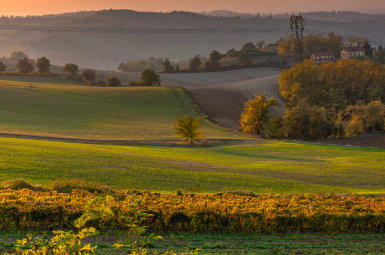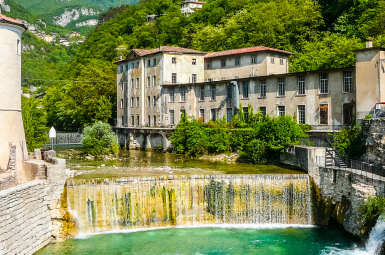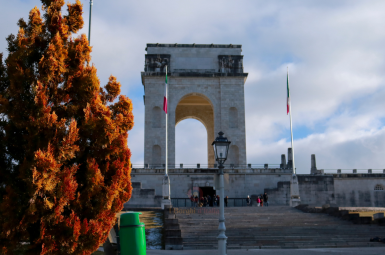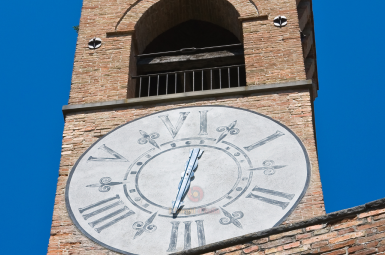
Pentedattilo
Il Borgo di Pentedattilo
Pentedattilo: La Mano di Pietra che Sfida il Tempo e la Leggenda
Non è solo un luogo, è un’icona scolpita dalla natura e intrisa di mistero. Pentedattilo non si presenta, si svela. Arroccato sulle pendici dell’Aspromonte, questo borgo della Calabria grecanica incanta i visitatori con la sua sagoma inconfondibile: una titanica mano di roccia, un tempo formata da cinque guglie che hanno dato il nome al paese (penta-dáktulos significa “cinque dita” in greco).Il Borgo Fantasma con l’Anima Greca
Pentedattilo è universalmente noto come uno dei borghi “fantasma” più suggestivi d’Italia. Abbandonato nel dopoguerra a causa dei rischi sismici e di una lenta emigrazione, ha rischiato di scomparire, ma la sua storia si è rifiutata di tacere.- Rinascita Artistica: Oggi, Pentedattilo non è più deserto. Grazie all’impegno di associazioni e artisti, le vecchie case diroccate e i vicoli silenziosi sono stati trasformati in botteghe artigiane, in laboratori e in gallerie. Il borgo ha trovato una nuova vita, diventando un faro per il turismo lento e per i festival culturali (come il Pentedattilo Film Festival), dimostrando che il suo fascino non è un semplice ricordo, ma una vitalità resiliente.
- L’Eredità Grecanica: Ci troviamo nel cuore dell’Area Grecanica della Calabria. Sebbene il borgo sia oggi prevalentemente di lingua italiana, Pentedattilo è un baluardo culturale dove l’antica lingua “greko di Calabria” (un dialetto di origine greca-bizantina) ancora echeggia nelle comunità limitrofe e nei rituali.
La Leggenda della Strage degli Alberti
L’aura sinistra che avvolge Pentedattilo è alimentata da una delle leggende più cruente del Sud Italia, la “Strage degli Alberti” del 1686.- Una Vendetta Sanguinosa: Si narra che il barone Bernardino Abenavoli di Montebello, respinto da Antonietta Alberti, erede del Marchese di Pentedattilo, si vendicò con una carneficina la notte di Pasqua. Il Barone e i suoi uomini irruppero nel Castello degli Alberti, massacrando l’intera famiglia e lasciando l’edificio in rovina come monito eterno.
- Le Voci nel Vento: La leggenda popolare vuole che la forma stessa della montagna sia la mano insanguinata di Bernardino, e che il vento che sibila tra le rocce non sia altro che l’eco delle urla del Marchese Lorenzo Alberti. Questa narrazione intrisa di passione, tradimento e vendetta amplifica il mistero e il fascino della visita.
Un Panorama Mozzafiato
Oltre la storia e il folklore, Pentedattilo regala un’esperienza visiva indimenticabile. Dalla sommità del borgo, lo sguardo spazia sulla Riviera dei Gelsomini, abbracciando la costa ionica. Nelle giornate limpide, la vista raggiunge lo Stretto di Messina e si spinge fino al profilo maestoso del Vulcano Etna in Sicilia. Visitare Pentedattilo è compiere un viaggio in una dimensione sospesa, dove la potenza della natura si fonde con il dramma umano, lasciando il visitatore con un senso di meraviglia e un brivido sottile. È la Calabria più misteriosa, autentica e poetica. Sei pronto a lasciarti afferrare dalla “mano di pietra” e a scoprire le storie che essa custodisce?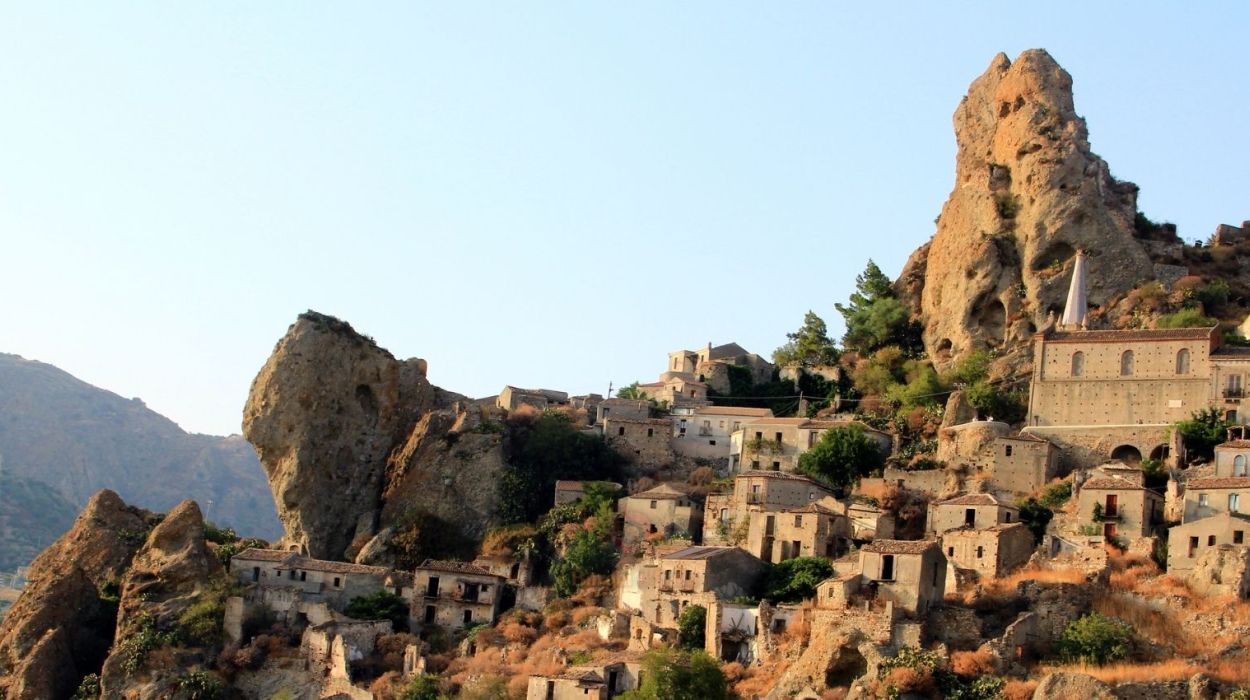
Il Borgo d’Italia
tutto da scoprire ed esplorare
Monumenti
L’Architettura del Silenzio: I Monumenti di Pentedattilo
Pentedattilo, il celebre “borgo fantasma”, non è definito da maestosi monumenti costruiti dall’uomo, ma dalla sua stessa, spettacolare conformazione: la sua architettura più imponente è la roccia che lo abbraccia. I suoi monumenti sono testimoni silenziosi di una storia di fasto, sangue e abbandono, incastonati tra la montagna e il mare Ionio.
1. La Cima Scultorea: La Rupe del Monte Calvario
È il monumento naturale più grandioso di Pentedattilo, la sua inconfondibile ragione d’essere.
- L’Opera d’Arte Geologica: La Rupe, un tempo chiaramente sagomata come una gigantesca mano con cinque dita protese verso il cielo, è ciò che ha dato il nome (dal greco Pentedáktulos) e la fama al borgo. Sebbene l’erosione e i terremoti ne abbiano modificato l’aspetto, essa rimane la cornice scenografica più drammatica della Calabria.
- Sentinella di Storia: La rupe sovrasta il borgo e offre un panorama mozzafiato che spazia fino all’Etna e alla Sicilia, fungendo da imponente simbolo di protezione e, secondo la leggenda, da macabra custode della “Strage degli Alberti”.
2. Le Fortificazioni e i Resti del Potere
Queste rovine sono i resti tangibili di un passato di dominio feudale e tensioni nobiliari.
- Il Castello (Rovine): Sulla sommità della Rupe si trovano i resti dell’antico Castello, un tempo la residenza della potente famiglia Alberti. Oggi è in gran parte diroccato, ma le sue vestigia permettono di immaginare l’antica roccaforte strategica che dominava l’intera Valle dell’Amendolea. È qui che, secondo il mito, si consumò la sanguinosa tragedia del 1686 che portò all’inizio del declino del borgo.
- Le Antiche Case in Pietra: Passeggiando tra i vicoli, le case abbandonate, con le mura in pietra che si fondono con la roccia circostante, sono un monumento alla vita contadina e pastorale di secoli fa. Molte sono state ristrutturate da artigiani e artisti, testimoniando la rinascita del borgo.
3. L’Eredità della Fede: La Chiesa dei Santi Apostoli Pietro e Paolo
È l’edificio religioso più importante di Pentedattilo e l’unico monumento a conservare una struttura quasi integra.
- Un Impianto Storico: Posta nel cuore del borgo, la Chiesa, sebbene restaurata più volte, risale a un’epoca precedente al Trecento. La sua importanza è storica: fu per secoli chiesa protopapale di rito greco, a testimonianza della forte influenza bizantina e dell’antica comunità ellenofona.
- Dettagli e Tesori (Perduti): L’interno custodisce i sepolcri della famiglia Alberti, legando indissolubilmente il luogo di culto alla leggenda del borgo. Un tempo ospitava preziose opere d’arte, inclusa una pala d’altare del XVII secolo purtroppo trafugata. L’edificio, con il suo campanile robusto, simboleggia la resilienza del borgo di fronte al tempo e all’abbandono.
Pentedattilo è un museo a cielo aperto dove la natura è l’artista principale e la storia ha lasciato cicatrici profonde. La visita ai suoi monumenti non è solo un tour architettonico, ma un viaggio intimo nella memoria della Calabria Grecanica.
Curiosità
Pentedattilo: Cinque Dita di Mistero e Rinascita 🖐️✨
Pentedattilo non è una semplice località; è una scultura geologica e una reliquia storica, un luogo dove ogni pietra sussurra antiche storie. Le sue curiosità affondano le radici nella morfologia unica del territorio, nel suo passato greco-bizantino e in leggende di sangue che hanno immortalato il suo silenzio.
1. La Curiosità Geologica: La “Mano del Diavolo”
Il nome stesso di Pentedattilo è la sua curiosità principale, derivante dal greco “Pentedáktulos” (cinque dita).
- La Forma Inconfondibile: Il borgo è letteralmente costruito attorno e sotto una gigantesca rupe rocciosa di arenaria, un tempo modellata in cinque maestose guglie, che richiamavano perfettamente la forma di una mano umana o, nel folclore, la “Mano del Diavolo”.
- Trasformazione Naturale: Purtroppo, a causa di terremoti (in particolare quello del 1783) e della naturale erosione, alcune delle dita rocciose sono crollate. Nonostante il profilo sia mutato, l’impatto visivo rimane drammatico e unico.
2. L’Eredità Linguistica: Un Baluardo della Magna Grecia
Pentedattilo sorge in un’area dal profondo retaggio culturale greco, l’Aspromonte meridionale.
- L’Isola Grecanica: Il borgo si trova nel cuore dell’Area Grecanica della Calabria, una delle ultime sacche linguistiche dove, nei paesi vicini come Bova o Gallicianò, si parla ancora il “greko” di Calabria, un idioma antichissimo di origine greco-bizantina che testimonia la permanenza della cultura della Magna Grecia fino ai giorni nostri.
- La Chiesa Bizantina: La chiesa dei Santi Apostoli Pietro e Paolo conserva l’impianto e l’atmosfera delle chiese di rito greco-ortodosso, anche se oggi è di rito latino, confermando la lunga influenza bizantina nella Valle dell’Amendolea.
3. La Leggenda e la Fama: Il Borgo Fantasma
La sua fama di “borgo fantasma” è legata a una storia cruenta che ne ha decretato, in parte, l’abbandono.
- La Strage degli Alberti (1686): L’evento più noto è la sanguinosa faida tra le famiglie nobili degli Alberti e degli Abenavoli, culminata in una strage notturna al Castello. La leggenda popolare vuole che gli spiriti delle vittime echeggino ancora tra le rocce, soprattutto nelle notti di forte vento.
- L’Abbandono e la Resilienza: Dichiarato inabitabile negli anni ’60 a causa del rischio idrogeologico, Pentedattilo fu abbandonato. Tuttavia, dagli anni ’80, il borgo ha visto una lenta ma significativa rinascita grazie a volontari e artisti da tutta Europa che hanno ristrutturato le vecchie case, trasformandole in botteghe e alloggi, restituendo vita al paese. Oggi, è un modello di turismo lento e recupero artistico.
4. L’Ispirazione per l’Arte e il Cinema
Pentedattilo ha esercitato un magnetismo irresistibile su artisti e cineasti internazionali.
- Edward Lear e M.C. Escher: L’artista e scrittore inglese Edward Lear fu tra i primi a documentare il borgo nel XIX secolo, definendolo “l’abitazione umana più strana”. Più tardi, anche il celebre litografo olandese M. C. Escher visitò la zona, traendo ispirazione per le sue architetture impossibili dalla roccia e dal paesaggio calabrese.
- Set Cinematografico: L’atmosfera sospesa e scenografica di Pentedattilo l’ha resa una location ideale per il cinema. È stata set di cortometraggi e lungometraggi, e ospita annualmente il Pentedattilo Film Festival, una rassegna internazionale dedicata ai cortometraggi che utilizza la sua atmosfera unica come sfondo per la creatività.
Personaggi
Pentedattilo: Un Borgo di Echi, Non di Nomi Celebri, Ma di Leggende Immortali
Pentedattilo, la spettacolare “mano di pietra” della Calabria grecanica, si distingue nel panorama storico non per una lunga lista di figure illustri nate tra le sue rocce, ma per aver generato una leggenda così potente da rendere la sua storia ben più celebre di qualsiasi singolo personaggio.
La fama di Pentedattilo non risiede nei natali di un filosofo o di un artista di fama mondiale, ma nel suo ruolo di palcoscenico immobile di un dramma storico e nella sua capacità di sedurre i grandi intelletti stranieri.
1. I Protagonisti Immateriali: Gli Alberti e Gli Abenavoli
I personaggi che hanno reso Pentedattilo celebre sono quelli legati alla “Strage della Pasqua” del 1686, un evento che miscela storia e folklore, proiettando i suoi sfortunati attori in un mito eterno:
- Il Marchese Lorenzo Alberti e Antonietta Alberti: La sventurata famiglia nobile di Pentedattilo, vittima della sanguinosa vendetta. Sebbene personaggi storici, la loro notorietà è interamente legata al mito dell’eccidio, che ha plasmato l’identità misteriosa del borgo. Si dice che le urla del Marchese echeggino ancora tra le rocce nelle notti di vento.
- Il Barone Bernardino Abenavoli: L’antagonista, l’amante respinto che per vendetta compì la strage. La sua figura è l’incarnazione della passione distruttiva e la leggenda lo vuole così macchiato dal sangue da aver trasformato la roccia in quella che, per un certo folklore, è la “Mano del Diavolo”.
La fama di questi personaggi non è data dalla loro vita, ma dalla loro tragica fine, che ha conferito a Pentedattilo il suo fascino tetro e magnetico.
2. Le Menti Sedotte: I “Visitatori” che hanno Riscritto Pentedattilo
Se Pentedattilo non ha generato figure di spicco, ha avuto l’eccezionale capacità di attrarre e ispirare alcuni dei più grandi artisti e intellettuali stranieri, i quali hanno portato la sua immagine nel mondo.
- Edward Lear (1812-1888): L’artista e viaggiatore inglese visitò il borgo nel 1847 e ne rimase totalmente affascinato. I suoi disegni e i suoi diari descrissero Pentedattilo come “la più strana abitazione umana”, contribuendo in modo decisivo a cementare la sua fama romantica e selvaggia in Europa.
- Maurits Cornelis Escher (1898-1972): Il celebre litografo olandese, maestro delle illusioni ottiche, fu anch’egli rapito dal fascino del borgo. Dai suoi numerosi viaggi in Calabria trasse ispirazione e soggetti, e la suggestiva architettura incastonata nella roccia di Pentedattilo si riflette in diverse delle sue incisioni, benché non sempre in modo diretto.
In definitiva, Pentedattilo è un luogo dove la leggenda supera la biografia. La sua vera grandezza risiede nel suo essere, non nel suo avere: un’opera d’arte naturale e narrativa che affascina da secoli, rendendola un personaggio più memorabile di molti uomini.
Ricette Tipiche
L’Elogio della Cucina Grecanica: Sapori Ruptestri del Borgo di Pentedattilo
La cucina di Pentedattilo non è racchiusa in ricettari da alta gastronomia, ma è un’espressione pura e ancestrale della tradizione agro-pastorale dell’Area Grecanica (Bovesia). Le sue ricette riflettono la necessità, l’ingegno e la connessione profonda con la terra aspra dell’Aspromonte e la vicinanza del mare Ionio.
I piatti sono un omaggio alla semplicità, alla robustezza degli ingredienti a chilometro zero e all’eredità culturale greca. Non si tratta di alta cucina, ma di alta memoria.
1. I Primi: La Forza del Grano e della Montagna
I primi piatti sono il cuore della tradizione culinaria di Pentedattilo, spesso preparati con formati di pasta lavorati a mano che esaltano sughi ricchi e saporiti, tipici della cucina contadina e pastorale.
A. I Maccarruni i Casa (Maccheroni con Sugo di Capra)
È il piatto più iconico della zona, un simbolo della cucina di montagna.
- L’Essenza: Maccheroni fatti in casa, tipicamente avvolti a spirale attorno a un sottile ferro da calza o a un “cannici” (un piccolo giunco). La loro consistenza ruvida è perfetta per raccogliere il sugo.
- Il Condimento: Un ragù di carne di capra a cottura lenta. La capra, animale tipico dell’Aspromonte, viene sfumata con vino e cotta per ore con cipolle, alloro e basilico, rilasciando un sapore intenso e selvatico. Spesso il piatto viene impreziosito da un tocco finale di ricotta salata grattugiata.
B. Pasta e Ricotta Frisca (Pasta e Ricotta Fresca)
Una ricetta della necessità che esalta la freschezza dei prodotti caseari locali.
- La Delizia: Un sugo semplice e velocissimo, a base di pomodoro fresco, cipolla e un pizzico di alloro, in cui viene incorporata a fuoco spento la ricotta fresca di pecora o capra (rigorosamente “frisca”). Il risultato è una salsa rosa, cremosa e delicata che avvolge formati di pasta corta o lunga come i perciatelli.
2. Le Specialità Fritte e da Strada: L’Anima Rustica
L’uso sapiente dell’olio locale, prodotto dagli ulivi secolari della Valle dell’Amendolea, trasforma ingredienti umili in vere prelibatezze.
A. La Lestopitta
Questa è l’autentica frittella grecanica, un pane non lievitato, veloce e croccante.
- L’Ingegno Povero: Simile a una piadina o a un pane fritto, è realizzata con un impasto semplicissimo di farina, acqua e sale. La sfoglia viene fritta in olio bollente fino a diventare dorata e gonfia.
- Il Gusto: Viene gustata calda, sia da sola come accompagnamento, sia farcita con ciò che la terra offre: formaggi locali, salumi, peperonata o, per i più audaci, una spalmata di ‘nduja piccante.
B. Frittata di Caciofuleddhi Servaggi (Frittata di Carciofini Selvatici)
Rappresenta la cucina delle erbe spontanee, ricchezza del paesaggio aspromontano.
- I Sapori della Terra: Una robusta frittata arricchita da carciofini selvatici (spesso germogli di cardo marino) raccolti lungo i sentieri. L’amaro tipico dei carciofi selvatici si sposa con l’uovo e il pecorino grattugiato.
3. I Sapori Dolci e l’Oro Verde: Bergamotto e Dolci Festivi
La cucina della zona attinge anche ai tesori della Costa Ionica, in primis il Bergamotto, agrume unico al mondo.
A. I Dolci della Tradizione
- Petrali e ‘Ngute: Dolci ricchi e aromatici, tipicamente preparati per le festività. I Petrali (dolci natalizi) sono a forma di mezzaluna e ripieni di frutta secca e fichi, mentre le ‘Ngute (o Scaddateddi) sono dolci lessati e poi fritti, spesso consumati nel periodo pasquale.
B. Il Bergamotto di Reggio Calabria
Pur non essendo un piatto, il Bergamotto è l’ingrediente profumato che influenza l’intera gastronomia locale. L’agrume, coltivato nella fascia costiera vicina a Melito di Porto Salvo, si ritrova in liquori, marmellate e nella pasticceria, aggiungendo una nota olfattiva e gustativa inconfondibile e preziosa ai prodotti del territorio di Pentedattilo.
La cucina di Pentedattilo è un invito a riscoprire l’autentico sapore della Calabria più profonda, dove ogni ricetta narra di fatica, di storia e del legame indissolubile tra l’uomo e la sua terra.
